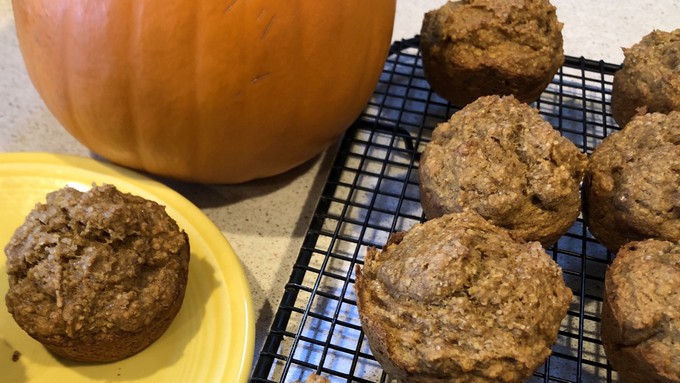
Make the most of bountiful harvests with these favorite recipes – all in one place

Pumpkin chai muffins -- just one of the harvest-inspired baking recipes in Taste Fall! Kathy Morrison
Fall may be our favorite season for cooking. We’re inspired by so much excellent produce – from our own gardens, farmers markets, farm stands and nearby orchards.
And during the five years of garden blog and recipe writing here at Sacramento Dig Gardening, we’ve created quite a few twists on fall favorites. And for the first time, you can find them all in one convenient curated space: Taste Fall!
This is our third e-cookbook, following Taste Spring! and Taste Summer! (Notice a theme?)
Each recipe features something we’ve harvested from our own gardens, or found at the local farmers markets and farm stands. Each recipe is tested, proven in our own kitchens.
Debbie’s bountiful apple, persimmon and pomegranate trees keep her busy. Kathy gravitates towards savory dishes, including soup. They both do plenty of baking – just in time for the holidays. After all, it’s cookie season!
Our fall vegetable menu also features chayote, corn, Brussels sprouts, broccoli, greens, beans and other nutritious and flavorful crops. There are so many delicious options, it’s no wonder we choose fall to celebrate our harvest and give thanks for our local bounty. (Why not celebrate with our French-inspired Provençal salad?)
In autumn, apple may be king, but it’s not the only fresh fruit that celebrates the season. Newly harvested pears, persimmons, pomegranates, figs, grapes, mandarins and limes all deserve to be showcased in fall baking and desserts. They also add juicy flavor to salads and side dishes. (We’ll show you how.)
If apples are your favorite fall fruit, go beyond basic apple pie with roasted apple tart or apple pie-cake. Or try adding those apples to crumble, coffee cake and bar cookies.
Sacramento’s tomato season extends well into October. Make the most of those late-season tomatoes in fresh tomato soup, tomato bread pudding or oven-roasted tomato jam.
Got pumpkin? Use that colorful pulp in muffins, mini-turnovers, creamy soup, hearty stew or pumpkin spice cake (with pumpkin spice latte buttercream frosting). Those other orange fall favorites – butternut squash and sweet potatoes – add flavor, moistness and antioxidants to breakfast, lunch, dinner and dessert.
In our Taste Fall! recipe collection, discover more than 65 delicious ways to enjoy our local harvest of fall fruit and vegetables. They’re at their very best right now – in season.
Comments
0 comments have been posted.Sacramento Digs Gardening to your inbox.
Food in My Back Yard Series
May 6: Maintain soil moisture with mulch for garden success
April 29: What's (already) wrong with my tomato plants?
April 22: Should you stock up on fertilizer? (Yes!)
April 15: Grow culinary herbs in containers
April 8: When to plant summer vegetables
April 1: Don't be fooled by these garden myths
March 25: Fertilizer tips: How to 'feed' your vegetables for healthy growth
March 18: Time to give vegetable seedlings some more space
March 11: Ways to win the fight against weeds
March 4: Potatoes from the garden
Feb. 25: Plant a fruit tree now -- for later
Feb. 18: How to squeeze more food into less space
Feb. 11: When to plant? Consider staggering your transplants
Feb. 4: Starting in seed starting
Sites We Like
Garden Checklist for week of May 4
Enjoy this spring weather – and get gardening!
* Plant, plant, plant! It’s prime planting season in the Sacramento area. Time to set out those tomato transplants along with peppers and eggplants. Pinch off any flowers on new transplants to make them concentrate on establishing roots instead of setting premature fruit.
* Direct-seed melons, cucumbers, summer squash, corn, radishes, pumpkins and annual herbs such as basil.
* Harvest cabbage, lettuce, peas and green onions.
* In the flower garden, direct-seed sunflowers, cosmos, salvia, zinnias, marigolds, celosia and asters. (You also can transplant seedlings for many of the same flowers.)
* Plant dahlia tubers. Other perennials to set out include verbena, coreopsis, coneflower and astilbe.
* Transplant petunias, marigolds and perennial flowers such as astilbe, columbine, coneflowers, coreopsis, dahlias, rudbeckia and verbena.
* Keep an eye out for slugs, snails, earwigs and aphids that want to dine on tender new growth.
* Feed summer bloomers with a balanced fertilizer.
* For continued bloom, cut off spent flowers on roses as well as other flowering plants.
* Add mulch to the garden to maintain moisture. Mulch also cuts down on weeds. But don’t let it mound around the stems or trunks of trees or shrubs. Leave about a 6-inch to 1-foot circle to avoid crown rot or other problems.